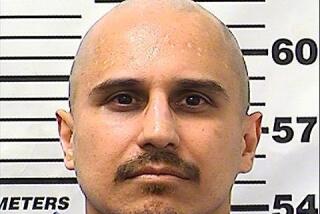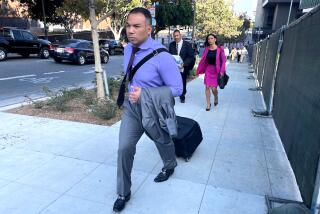San Diego
- Share via
The death-penalty murder trial of Carlos Villa Fonseca began Monday with opening statements by attorneys on both sides who said the accused slayer of four was involved in a drug business operated out of a College Grove house where the victims were shot in 1986.
Fonseca, 24, a former Reno construction worker, is accused of murdering four people and critically wounding a fifth on Dec. 28 of that year after a robbery attempt at 3428 Hasty St. failed to yield any money derived from the sale of illicit drugs.
If convicted, Fonseca could be sentenced to death because of the multiple murders and because they were committed during a robbery.
Killed were Rosa Partida Medina, 25, the alleged leader of the cocaine and heroin drug ring; Enrique Mejia Beltran, 25; Migule Martinez Vasquez, 20, and Augustine Farfan, who investigators say was about 21. All were Mexican nationals.
Armando Garcia Rubio, who was shot twice but survived, will be the star witness in Deputy Dist. Atty. Mark Pettine’s case.
According to Garcia’s earlier testimony, a second gunman was at the house the night of the killings, but a suspect has never been apprehended.
The prosecution will argue that Fonseca had fallen out of favor with the drug ring and that he needed money to support his wife.
The defense will argue that Fonseca was in Reno, Nev., with his wife between Christmas, 1986, and New Year’s Day, 1987.
In her opening statements, defense attorney Deborah Carson said she will focus on, among other things, the lack of physical evidence linking Fonseca to the crime scene.
In his opening statements, Pettine painted a picture of Fonseca as a man who was drawn into the underground world of drugs because it offered the Mexican national a great deal of money.
Pettine said Fonseca thought more money could be made in the operation, which operated out of several houses in Southeast San Diego, and that Fonseca’s wife was “incurring substantial medical bills she couldn’t pay.”
After falling out of favor with Partida, Fonseca traveled back and forth from San Diego to Reno, where his wife lived, Pettine said.
On Dec. 28, 1986, Fonseca went to Partida’s house, which was the center of the drug ring’s operations, and he demanded money from two drug ring workers he found there, Pettine said.
Later, when the other three victims arrived and he was not given any money, Fonseca allegedly herded all five of them into the kitchen, had them lie on the floor and shot them, Pettine said.
More to Read
Sign up for Essential California
The most important California stories and recommendations in your inbox every morning.
You may occasionally receive promotional content from the Los Angeles Times.













